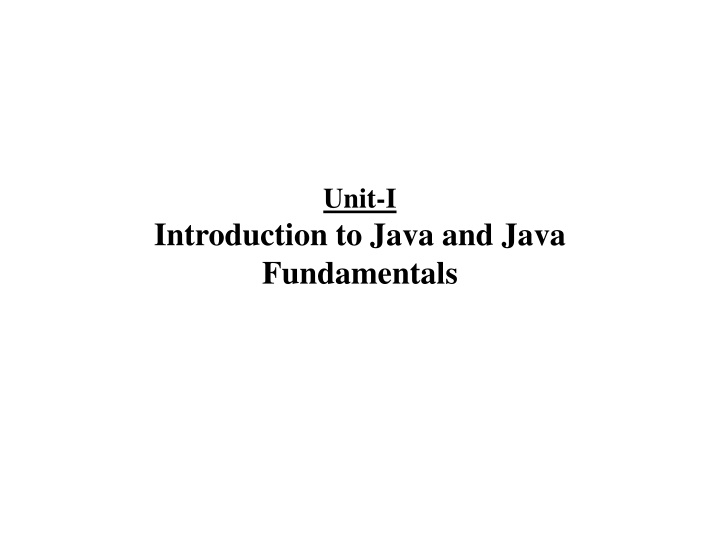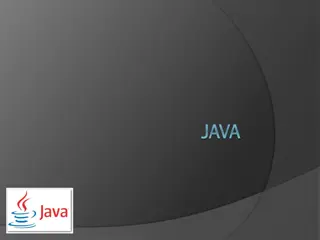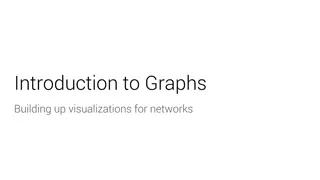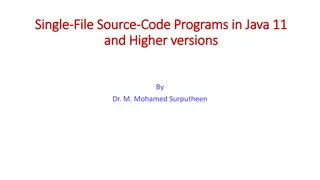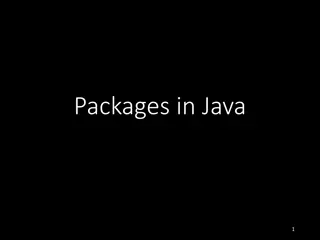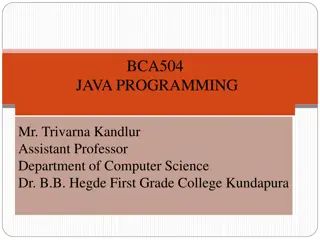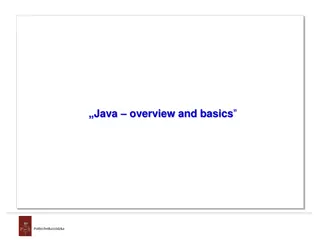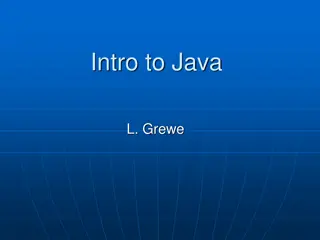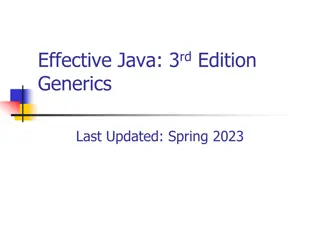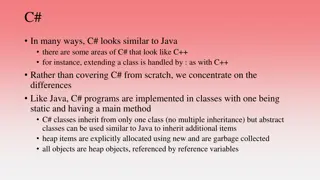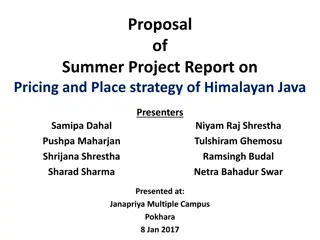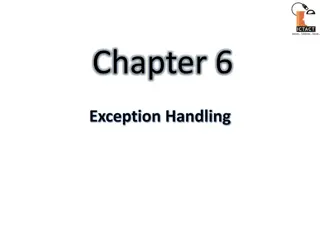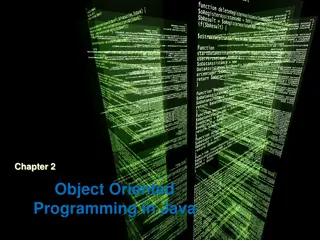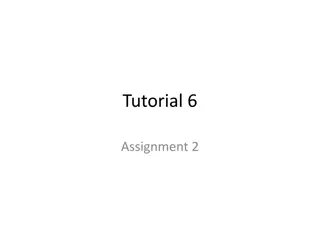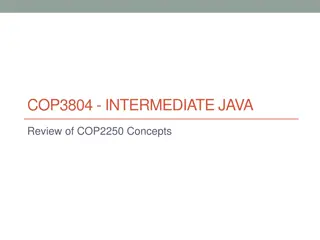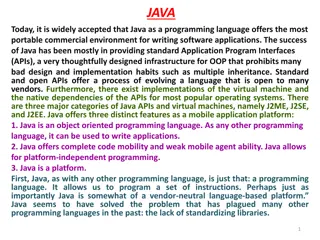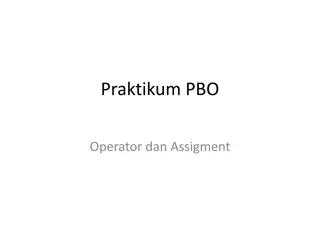Introduction to Java and Fundamentals
Java, a general-purpose and object-oriented programming language, has a rich history starting with the Green Team at Sun Microsystems. Learn about the features of Java, its simple syntax based on C and C++, object-oriented programming methodology, and the compiled and interpreted nature of Java programs.
Download Presentation

Please find below an Image/Link to download the presentation.
The content on the website is provided AS IS for your information and personal use only. It may not be sold, licensed, or shared on other websites without obtaining consent from the author.If you encounter any issues during the download, it is possible that the publisher has removed the file from their server.
You are allowed to download the files provided on this website for personal or commercial use, subject to the condition that they are used lawfully. All files are the property of their respective owners.
The content on the website is provided AS IS for your information and personal use only. It may not be sold, licensed, or shared on other websites without obtaining consent from the author.
E N D
Presentation Transcript
Unit-I Introduction to Java and Java Fundamentals
L ecture C ontents History of Java Features of Java
History of Java History of Java starts with green team. In 1990, Sun Microsystems funded an internal research project Green to develop a language for digital devices. James Gosling, Mike Sheridan and Patrick Naughton initiated this project in 1991 and resulted in a programming language Greentalk which then renamed as Oak . There was already a programming language called Oak so green team again renamed it with Java in 1995, the name taken from Java Coffee. Java was originally designed for small embedded systems in electronic application like set top boxes, TVs, VCRs, Toasters, Microvaves, Washing Machines etc.
James Gosling Mike Sheridan Patrick Naughton Green Team
So Java originally developed by James Gosling and team at Sun Microsystems which is now a subsidiary (2010)of Oracle Corporation. Java is general purpose and object oriented programming language. The extension of java program file is .java First Java version was released in 1995 with name JDK Alpha and Beta. In very next year, 1996 , JDK 1.0 released and since then number of Java versions have been released. JDK 14 i.e. Java SE 14 has released in March ,2020.
Features of Java Familiar, Simple Object-Oriented Compiled and Interpreted Platform-Independent Portable Architecture Neutral Robust Secure High Performance Multithreaded Distributed Dynamic and Extensible
Familiar, Simple Java is very easy to learn, and its syntax is simple, clean and easy to understand. Java syntax is based on C and C++ Java has removed many complicated , confusing , ambiguous, and rarely-used features, for example, explicit pointers, operator overloading, etc. Object Oriented Object-oriented programming (OOPs) is a methodology that simplifies software development and maintenance by providing some rules and concepts. In Java, everything is an object, which has some data and behavior. All Java program code resides in class/classes and handled using objects. Java has extensive set of predefined classes (utilities, I/O, GUI, Networking, WWW, HTML etc. )and these are arranged in packages.
Compiled and Interpreted Java is a two stage system. In first stage, Java program is compiled i.e. the java program is translated into the byte code. For compilation javaccompiler is used. The byte code is intermediate code, it is not a low level code so it is some what in readable form. This code is not understandable to machine. So to convert byte code to machine instructions and to execute this code, java interpreter is used at second stage.
Hardware and Operating System Programmer Source Code Byte Code Text Editor Compiler Interpreter .java file .class file java/ appletviewer Notepad, emacs,vi javac
Platform Independent A platform is the environment where program runs. It can be software platform or hardware platform Java provides software platform to execute java programs. Java programs can be moved from anywhere to anywhere i.e. Write Once and Run Anywhere (WORA) The byte code generated by java compiler (javac) is platform independent It means, we can take this byte code i.e. .class file and execute it in any platform using java interpreter (java).
JAVA COMPILER (translator) JAVA BYTE CODE (same for all platforms) JAVA INTERPRETER (one for each different system) Windows Macintosh Solaris Linux
Portable Porting the java program or system to any new platform involves the only existence of an interpreter. The interpreter will figure out what the equivalent machine dependent code to run Byte code generated at one platform can be implemented on any machine.
Architecture Neutral In Java, size of primitive data types is machine independent. In C programming, int data type occupies 2 bytes of memory for 32-bit architecture and 4 bytes of memory for 64-bit architecture. However, it occupies 4 bytes of memory for both 32 and 64- bit architectures in Java.
Robust Java is strong in memory management. There is automatic garbage collection which get rid of objects which are not being used by a Java application anymore. There are exception handling to handle the exceptions and the type checking mechanism make Java more robust.
Secure Absence of pointer concept in Java ensures that program cannot access memory location without prior permissions. Java program always runs in the Java Runtime Environment so almost no interaction takes place with native operating system. High Performance Performance of Java is impressive because of byte code and feature like multithreading. But little but slower as compared to C and C++.
Multithreaded We can write Java programs that deal with many tasks at once by defining multiple threads. A thread is like a separate program, executing concurrently. The main advantage of multi-threading is that it doesn't occupy memory for each thread. Distributed It is designed as distributed language for creating network applications. RMI and EJB are used to create distributed applications. Java applications can access remote objects or can communicate to many locations on the network.
Dynamic and Extensible Java is capable of loading classes on demand. Java programs support functions written in other languages like C and C++. It enables programmers to use efficient functions available from other languages
